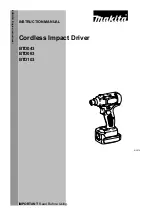
GETTING TO kNOW YOUR TOOL
SPECIFICATIONS
Model ........................................................................................................................8055L
Voltage ................................................................................................................20V MAX
Quick release chuck ..........................................................................................1/4” (hex.)
Speed range ..................................................................................................0-2000 RPM
Impacts per minute ..................................................................................................0-3300
Torque ..............................................................................................................1,350 in/lbs
1. 1/4” hex. drive quick release chuck
2. LED work light
3. Variable speed trigger
4. Forward/reverse switch
5. 20V MAX Li-ion cordless impact driver
Not shown:
• Battery power level indicator
• Bit holder
• 4 nut drivers with 1/4” hex. shank,
6 screwdriver bits (Robertson #1 & #2,
Phillips #1 & #2, 5mm & 6mm flat),
bit extension
Figure 1
OPERATION
Using your 20V MAX Lithium-ion cordless impact driver
Important Note:
This Impact Driver does not come with a
battery or charger, if you already own a 20V max Li-ion cord-
less tool you may use its battery (K-020LBT) and charger (K-
020LCG) as they are interchangeable. If not, it will be nec-
essary to purchase a battery and charger.
WARNING:
Do not install battery until the accessory is
installed securely to the tool.
Wear protective gloves and
safety glasses,
an accessory can become extremely hot dur-
ing operation, danger of burns!
Charging the battery/battery level indicator
20V max Li-ion batteries come with a battery power level
indicator (A) Fig.2, press the button (B) to see the charge
level. If the battery level is low charge the battery. To charge
the battery (C) Fig.2, plug charger (D) power cord into a
120V AC receptacle (do not use extension cord). The green
LED (E) will flash to indicate power to the charger. Align the
grooves the battery with those of the charger and slide the
battery all the way until it snaps into place. The red LED (F)
will light up indicating the charging procedure has begun.
Once the green LED (E) lights up, the battery is fully charged
and ready to use. Press the battery clip (B) Fig.3 to remove
battery from charger.
Installing/removing battery from impact driver
To install a battery (A) Fig.3 to the base of the cordless
impact driver, align the grooves the battery with those of the
impact base and slide the battery all the way until the battery
clip (B) snaps and holds the battery into place.
To remove the battery from the base, press the battery clip
(B) Fig.3 and slide the battery away from the base.
Variable speed trigger
Your cordless impact driver is equipped with a variable
speed trigger (A) Fig.4. The speed can be controled from the
minimum to the maximum RPM just by the pressure applied
to the trigger switch. Apply more pressure to increase speed
and apply less pressure to decrease speed. Release trigger
to stop impact driver.
Forward/reverse switch and trigger lock
Your cordless impact driver is equipped with a
forward/reverse switch and trigger lock (B) Fig.4. It is located
above the trigger. This switch is designed to change the
direction of rotation of the chuck and to lock the trigger to
help prevent accidental starts and battery discharge. For a
forward rotation (with the chuck pointing away from you) move the lever to the left. For reverse
rotation move the lever to the right. To lock the trigger, place the lever in the centre position.
WARNING! Do not change the rotation direction until the impact driver chuck has come
to a complete stop. Changing the rotation during an operation can cause damage to the
tool.
Electric brake
This impact driver is equipped with an electric brake. If the tool consistantly fails to stop quickly
after the trigger is released, have the tool serviced.
Figure 2
Figure 3
Figure 4






















